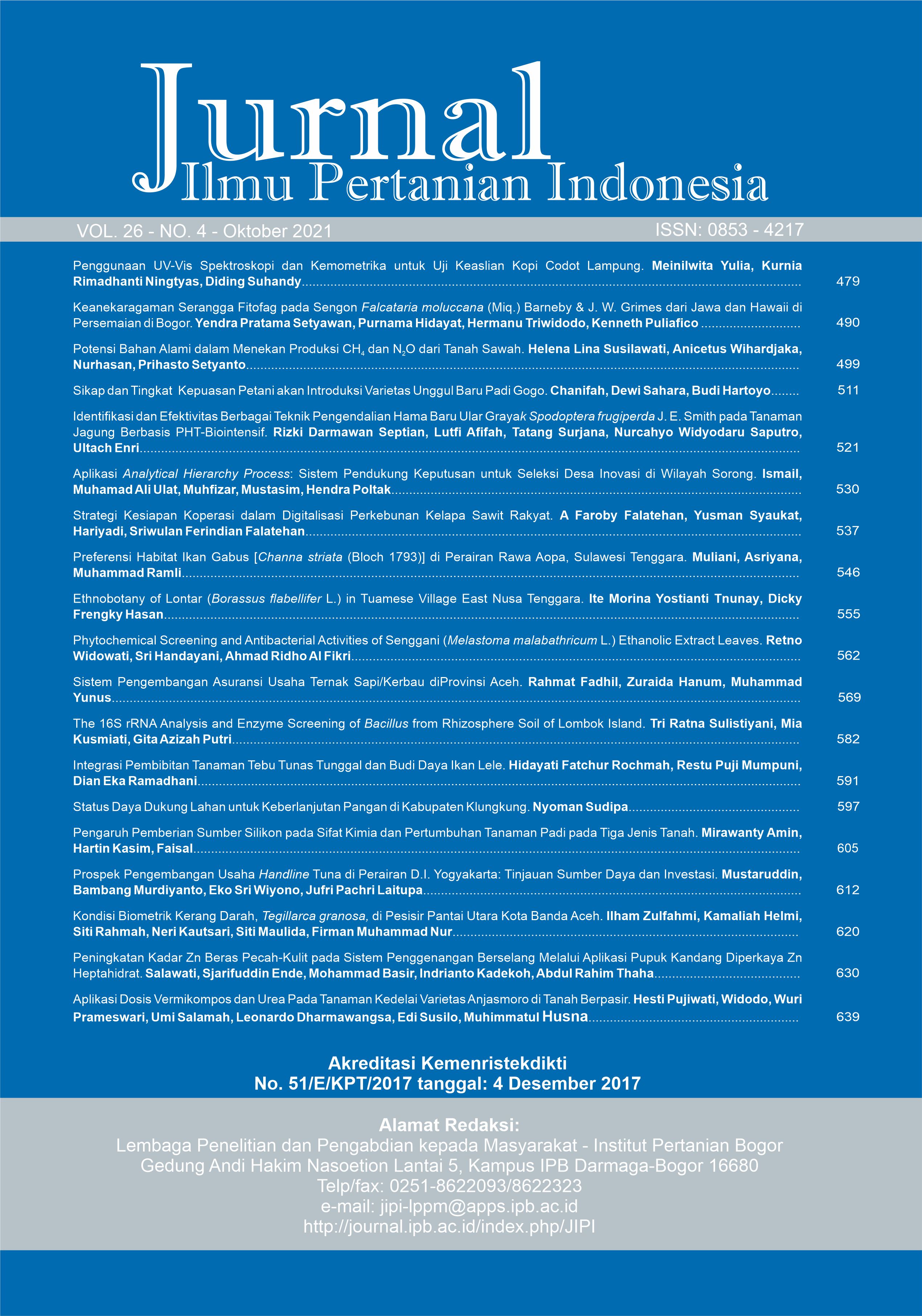Ethnobotany of Lontar (Borassus flabellifer L.) in Tuamese Village, East Nusa Tenggara
Abstract
Lontar is a plant that distributed in tropical areas and has beneficial values for the people in Tuamese Village, Biboki Anleu District, North Central Timor Regency. However, the information about the ethnobotany of lontar is not documented. This research aimed to determine the utilization of lontar in Tuamese Village. Data were collected using semi-structured interview techniques and field observation. The ethnobotany data were analyzed to calculate cultural significance index value. The results showed that the people in Tuamese Village who generally work as lontar farmers use stem, leaves, flowers, and fruit as building and fence materials, handicraft materials, food and drink ingredients, and firewood. Product from sap flower, namely liquid sugar, slab sugar, and traditional fermented drink (sopi) are the leading trade commodity. The utilization of lontar in Tuamese Village is grouped into seven forms of utilization with index of cultural significance 151 and classified very high. The classification means that lontar greatly affects people's lives in Tuamese Village and its use has become cultured. People's dependence on lontar is very high so the conservation effort needs to make the existence of lontar is maintained.
Keywords: index cultural significance, lontar, Tuamese
Downloads
References
Age DL, Hendrik Ach and Rupidara AND. 2019. Ethnobotany study of lontar tree (Borassus flabellifer L.) at Raijua Island. Proceeding of International Seminar on Chemical Engineering Soehadi Reksowardojo (STKSR). https://doi.org/ 10.1088/1757-899X/823/1/012048
[BPS TTU] Badan Pusat Statistik Kabupaten Timor Tengah Utara. 2018. Kecamatan Biboki Anleu dalam Angka. Kefamenanu (ID): BPS Kabupaten Timor Tengah Utara.
Basir AA, Lahjie AM, Simarangkir BDAS, Matius P. 2015. Mengukur kepentingan budaya dari sumber daya hutan melalui kajian etnobotani kuantitatif. Jurnal Teknologi Pertanian. 10(1): 8-17.
Fajeriadi H, Dharmono, Anwar MR. 2019. Kerapatan lontar (Borassus flabellifer L.) di Hutan Pantai Desa Tabanio, Kalimantan Selatan. Enviro Scienteae. 15(2): 190-194. https://doi.org/10.20527/es.v15i2.6 949
Haisya NBS, Utama BD, Edy RC, Aprilia HM. 2011. The potential of developing siwalan lontar sugar (Borassus flabellifer L.) as One of the Bioethanol Sources to Overcome Energy Crisis Problem in Indonesia. Proceeding of 2nd International Conference on Environmental Engineering and Applications IPCBEE. 17: 89-93.
Jehamat A, Moenthe UG, Katipana N. 2017. Pemanfaatan nira lontar sebagai bahan pakan sumber energi tambahan bagi ternak babi dan perbandingannya untuk memproduksi gula. Partner. 1: 87-93.
Kurniawan T, Jayanudin, Kustiningsih I, Firdaus MA. 2018. Palm sap sources, characteristics, and utilization in Indonesia. Journal of Food and Nutrition Research. 6(9): 590-596. https://doi.org/1 0.12691/jfnr-6-9-8
Nasri, Suryaningsih, Kurniawan E. 2019. Ekologi pemanfaatan, dan sosial budaya lontar (Borassus flabellifer L.) sebagai Flora Identitas Sulawesi Selatan. Info Teknis EBONI. 14(1): 35-46.
Rodiah MH, Jamilah B, Kharidah SM, Russly AR. 2019. Physico-chemical and antioxidant properties of mesocarp and exocarp from Borassus flabellifer. International. Food Research Journal. 26(5): 1469-1476.
Saputro AD, de Walle DV, Dewettinck K. 2019. Palm sap sugar: a review. Sugar Tech. 21: 862-867. https://doi.org/10.1007/s12355-019-00743-8
Singh A, Singh PK. 2009. An ethnobotanical study of medicinal plants in Chandauli District of Uttar Pradesh, India. Journal of Ethnopharmacology. 121(2): 324-329. https://doi.org/10.1016/j.jep.2008. 10.018
Tambunan P 2010 Potensi dan kebijakan pengembangan lontar untuk menambah pendapatan penduduk. Jurnal Analisis Kebijakan Kehutanan. 7(1): 27-45. https://doi.org/10.20886/ja kk.2010.7.1.27-45
Tardio J, de Santayana MP. 2008. Cultural Importance Indices: A comparative analysis based on the useful wild plants of Southern Cantabria (Northern Spain). Economic Botany. 62(1): 24-39. https://doi.org/10.1 007/s12231-007-9004-5
Thibab N, Hayati A, Zayadi H. 2019. Studi etnobotani dan distribusi tanaman siwalan di Desa Gapura Timur Kecamatan Gapura Kabupaten Sumenep Suku Madura. e-Jurnal Ilmiah Biosaintropis. 4: 15-20.
Turner NJ. 1988. The Importance of a Rose”: Evaluating the cultural significance of plants in Thompson and Lillooet Interior Salish. American Anthropologist. 90(2): 272-290. https://doi.org/10.1 525/aa.1988.90.2.02a00020
Vengaiah PC, Kumara VB, Murthy GN, Prasad KR. 2015. Physico-chemical properties of palmyrah fruit pulp (Borassus flabellifer L). Nutrition and Food Sciences. 5(5): 1-4. https://doi.org/10.4172/2155 9 600.1000391
This journal is published under the terms of the Creative Commons Attribution-NonCommercial 4.0 International License. Authors who publish with this journal agree to the following terms: Authors retain copyright and grant the journal right of first publication with the work simultaneously licensed under a Creative Commons Attribution-NonCommercial 4.0 International License. Attribution — You must give appropriate credit, provide a link to the license, and indicate if changes were made. You may do so in any reasonable manner, but not in any way that suggests the licensor endorses you or your use. NonCommercial — You may not use the material for commercial purposes.






















